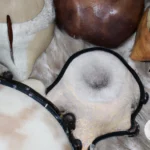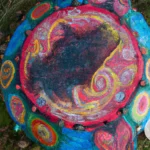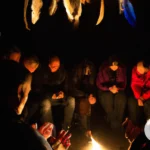The beating of a shamanic drum is a powerful tool for connecting with the spiritual realm. For those seeking a heightened level of ceremony and connection, making your own shamanic drum can be a deeply rewarding experience. However, many people are unsure where to begin or daunted by the process. Fear not, for with a few materials and some dedication, crafting your own drum can be a fulfilling and enlightening journey. In this step-by-step guide, we will walk you through the process of creating your own shamanic drum, from selecting materials to connecting with your finished product.
What is a Shamanic Drum?
A Shamanic Drum is a type of drum that has been used for centuries in shamanic practices. It is a deep-throated drum that produces a rhythm that is repetitive and soothing, which is believed to be conducive to trance-like states that allow the shaman to enter the spirit world. These drums are typically made from natural materials, such as wood and animal hide, and are often decorated with spiritual symbols and imagery.
Shamanic drums are one of the many different types of drums used in shamanism. Each type of drum has its distinctive characteristics and uses, but the shamanic drum stands out for its unique sound and its vital role in shamanic journeying.
The history of the shamanic drum is fascinating, with evidence of its use dating back thousands of years. Many indigenous cultures around the world use the shamanic drum as part of their traditional spiritual practices. The drum has been used for healing purposes, as well as for divination, vision quests, and other spiritual practices.
In recent years, there has been a growing interest in the use of shamanic drums for sound healing therapies. The repetitive, soothing rhythms of the drum can help to induce a meditative state and have been shown to have a positive impact on the nervous system. Many therapists use shamanic drums as part of their sound healing sessions.
Learning how to make your own shamanic drum is an exciting and rewarding experience. It allows you to connect with the sacred tradition of drum making and create a unique instrument tailored to your individual needs. In the following sections, we will guide you through the step-by-step process of making your own shamanic drum.
Why Make Your Own Shamanic Drum?
Making your own shamanic drum is a meaningful and spiritual experience that connects you with the ancient art of drum making. It allows you to create a tool that is unique to your spiritual practice and journey. When you make your own drum, you pour your energy, intention, and love into every aspect of the process, from selecting the materials to putting the finishing touches on the drum.
Creating your own shamanic drum provides you with the opportunity to learn about the history and traditions of drum making in different cultures. Learning about the different materials and techniques used to make shamanic drums can deepen your understanding and appreciation of the mystical and spiritual aspects of drumming.
In addition to the spiritual benefits, making your own shamanic drum can improve your drumming practice. The process of creating a drum allows you to understand the mechanics of how it works and how to properly care for it. This knowledge can help you make the most out of your drumming practice, whether that be for shamanic journeying, meditation, or sound healing.
Making your own shamanic drum is an incredibly rewarding experience that can deepen your spiritual practice, improve your drumming skills, and provide a sense of connection to ancient traditions. If you are interested in learning more about shamanic drumming, check out our article on shamanic drum history.
What You Will Need
When it comes to making your own shamanic drum, there are certain tools and materials you will need to ensure that your drum is of high quality and durable. To create the frame, you will need a saw, drill, sandpaper, and the wood of your choice. Popular woods used for shamanic drums are maple, oak, and cedar. For the drumhead, you will need rawhide, typically from a cow or elk. Additionally, you will need strong, waxed nylon thread and a large needle for stitching it to the frame. Other optional materials to customize your drum can be feathers, beads, and paint. To get started, it’s important to have a clear vision of how you want your drum to look and sound, so that you can select the appropriate materials for your needs.
Choosing Your Materials
Choosing Your Materials
When it comes to choosing the materials for making your own shamanic drum, there are a few things to consider. The most important materials for the drum are the frame and the hide.
The Frame
The frame is the structure of the drum and can be made from a variety of different materials. Traditionally, the frame is made from wood, but you can also use metal, plastic, or other materials.
Wooden frames are the most popular choice, and you can choose from a variety of types such as oak, maple, or ash. When selecting the wood for your drum, make sure it is thick and strong enough to support the tension of the drumhead.
The Hide
The hide is what gives the drum its unique sound. Traditionally, shamanic drums were made using animal hides. You can still use animal hides if you prefer, but there are also synthetic options available that can be more ethical and sustainable.
If you choose to use animal hide, make sure it is from an animal that was ethically sourced and not taken for its hide alone. Deer, elk, and buffalo hides are popular choices. Synthetic options such as mylar or fiberglass can also be used.
Other Materials
In addition to the frame and the hide, you will also need some additional materials such as a hammer, nails, and sandpaper. You may also want to consider adding decorative elements such as beads, feathers, or paint to your drum.
When choosing your materials, consider the intended use of your drum. Will it be used for personal meditation or shamanic journeying? Or will you be using it in a group setting for drumming circles and shamanic practices?
No matter what materials you choose, make sure they are of high quality and reflect your intention for the drum. Remember, the materials you choose will have a direct impact on the final sound and energy of your shamanic drum.
To learn more about the different types of shamanic drums, check out our article on drum types in shamanism.
Step-by-Step Guide
To create your own shamanic drum, you will need to follow a step-by-step guide that outlines the process. It’s important to take your time with each step to ensure the drum is crafted properly and with intention. This process involves preparing the hide, cutting and sanding the frame, assembling the frame, stretching the hide, and finishing with personal touches. Once complete, it’s essential to connect with your drum and give it a proper cleansing and blessing. Playing the drum is a significant part of shamanic practice and can be used for sound healing, shamanic journeying, and connecting with the spiritual world. For more shamanic drumming techniques, consider joining a drumming circle or exploring the effects of shamanic drumming on the nervous system.
Preparing the Hide
The first step in making a shamanic drum is to prepare the hide. You can use the hide of any large animal, such as a deer or elk. It is important to use a fresh hide that has not been preserved with chemicals, as these can affect the sound and vibration of the drum.
Begin by soaking the hide in water for several hours to soften it. Once it has soaked, stretch it out on a flat surface and use a fleshing tool to remove any remaining flesh and fat. This will ensure that the hide is as thin and flexible as possible.
Next, trim any excess skin or fur from the edges of the hide. You can use a sharp utility knife or scissors for this. Be sure to leave enough extra material around the edges to wrap around the drum frame later on.
Once the hide has been prepared, you can begin to work on the drum frame. If you need more information about drum frames or want to deepen your knowledge on shamanic drumming and its effects on the nervous system, click on Shamanic Drumming Nervous System Effects and read this interesting article.
Cutting and Sanding the Frame
Once you have your materials ready, the next step in making your own shamanic drum is to cut and sand the frame. Most shamanic drums are circular in shape, so you’ll need to create a circular frame. Use a jigsaw or circular saw to cut the shape from your chosen wood. One popular wood for drum frames is maple, but you can also use oak, ash, or other hardwoods.
After cutting the frame, use sandpaper to smooth out the edges. If you want a more polished look, you can use a wood planer or belt sander to achieve a smooth surface. It’s important to take your time with sanding to ensure that the frame is smooth and free from any rough spots or splinters.
Keep in mind that the size of the frame will determine the size of the drum. Most shamanic drums range in size from 14 to 18 inches in diameter, but you can make your drum any size you prefer. Just be sure that the size of the drum head corresponds to the size of the frame.
Once your frame is cut and sanded to your satisfaction, you can move on to assembling the frame. This involves connecting the separate pieces of the frame using wood glue and clamps. You’ll also need to drill holes around the edge of the frame to attach the drum head.
Interested to read more about Shamanic Drumming? Check out our article about shamanic drumming and brainwaves.
Assembling the Frame
Assembling the Frame: After cutting and sanding the frame, it’s time to start assembling it. Begin by laying out the four frame pieces on a flat surface, with the top side facing down. Then, take two of the pieces and line them up so that the ends are flush, making sure that they are angled toward each other to form a diamond shape in the center. Use clamps to secure the pieces in place, then apply wood glue to the mitered ends.
Next, take the remaining two pieces of the frame and repeat the process, lining up the ends to form another diamond shape. Apply glue to the mitered ends and then attach the second set of pieces to the first, using clamps to hold everything securely in place. Make sure that the joints are tight and the angles are correct. Leave the glue to dry for at least 24 hours before proceeding.
Once the glue has dried, it’s time to strengthen the joints. Cut four small pieces of wood, each about 2 inches in length, and apply glue to one end of each piece. Insert the pieces into the joints where the frame pieces meet, making sure that they fit snugly. These pieces, called splines, will add extra stability to the joints. Once the glue has dried, use a saw to trim off the excess splines so that they are flush with the frame.
Finally, sand the entire frame, including the joints, until everything is smooth to the touch. You can also add a decorative touch if you like, such as carving or painting a design onto the frame.
Internal link: If you are interested in learning more about the power of shamanic drumming, check out our article on drumming in shamanic journeying.
Stretching the Hide
Once you have the frame assembled, it’s time to stretch the hide over it. Begin by soaking the hide in water for a few hours, so it becomes pliable. Then, using a strong cord, tie one end of the hide to the frame. Begin stretching the hide by pulling it taut and tying it to the frame at regular intervals. Always work your way from the center of the drum outwards, as evenly as you can. This will ensure an even distribution of tension and avoid creating any uneven bumps or lumps on the surface of the drum.
Tightening the Hide
When you’ve stretched the hide across the entire frame, it’s time to tighten it. Start by tightening the vertical cords first and then work on the horizontal cords. Tighten the cords gradually, one at a time. Be aware that as you tighten one cord, it will affect the tension in the others. So, it’s a good idea to go around the drum several times, tightening each cord a bit at a time, to ensure an even tension.
Checking and Adjusting the Tension
When you think you’ve tightened the cords enough, tap the drumhead gently with a mallet to check the tone. If it’s not tight enough, the drum will have a dull and flat sound. If it’s too tight, the drum will have a high-pitched tone and may even crack. Use your intuition and adjust the tension of the hide until it feels just right. Remember, it’s important to respect the hide as a living being and treat it with care and gratitude.
Final Touches
Once you’ve achieved the right tension, trim off any excess material from around the edge of the frame. You can then decorate the drum by painting or staining the frame, or adding beads, feathers, or other embellishments. The drum will need to dry completely before you can play it. This can take a few days to a week, depending on the humidity and temperature of the environment.
Congratulations, you’ve now made your own shamanic drum! Take some time to connect with your drum in a quiet and sacred space. You may want to meditate with it, set intentions for your drumming practice, or simply appreciate the beauty and power of this ancient instrument. Remember to cleanse and bless your drum regularly and show it the respect it deserves. With your new drum, you can explore the world of sound healing, shamanic drumming circles, and intention setting.
Finishing Touches
Finishing Touches: Now
Subscribe to Our Newsletter
Sign up to receive the latest news and updates.
Another finishing touch is to add a strap to your drum so that you can easily carry it to drum circles or other events. You can use leather straps or other materials to create a comfortable and durable strap. Make sure that the strap is securely attached to the drum frame so that you can use it with confidence.
Finally, consider adding a design or symbol to the surface of the hide to imbue your drum with additional meaning. This could be a personal symbol or even a traditional shamanic symbol that you feel drawn to. You can use paint, markers, or other materials to add your design. Be sure to use non-toxic materials and to let the design dry completely before playing your drum.
Remember, the finishing touches are what really make your drum unique and special. Take your time and enjoy the process of making your drum truly yours. And when you’re finished, be sure to use it as a tool for healing, transformation, and connection with the spirit world. You can use your drum in sound healing, shamanic drumming circles, and other spiritual practices to deepen your connection with yourself, others, and the earth. Set your intentions for how you will use your drum, and let its powerful vibrations guide you on your journey.
Connecting with Your Drum
Connecting with your shamanic drum is an important part of the drum-making experience. Your drum is more than just a musical instrument, it is a sacred tool that can be used for spiritual work and healing. To connect with your new drum, sit with it in a quiet space and hold it gently. Close your eyes and take a few deep breaths, feeling the energy of the drum in your hands. You may also choose to play your drum softly, feeling the vibrations through your body. As you connect with your drum, consider joining a drumming circle to deepen your connection and share your practice with others. Drumming circles are a common practice in shamanic traditions and can be a powerful way to connect with the spirit world. To learn more about drumming circles and shamanic practice, check out /drumming-circles-shamanic-practice/.
Cleansing and Blessing Your Drum
Cleansing and Blessing Your Drum
The process of cleansing and blessing your shamanic drum is an important step in preparing it for use. This step is believed to imbue the drum with spiritual power and to establish a strong connection between the drum and its user. Here is a step-by-step guide:
| Step | Actions |
| — | — |
| 1. | Find a quiet and peaceful place to work where you won’t be disturbed |
| 2. | Smudge the drum and yourself with burning sage or palo santo to clear away any negative energy |
| 3. | Hold the drum and set your intention for its use |
| 4. | Using a feather or your hand, sprinkle tobacco or cornmeal over the drum to bless it |
| 5. | Play the drum softly, gradually building up to a louder sound as you focus on your intention |
| 6. | Thank the spirits, your ancestors, and any other guides that you work with for their help and guidance |
| 7. | Store your drum in a safe, dry place where it won’t be disturbed until you are ready to use it |
This ritual is often performed before and after drumming sessions to maintain the spiritual connection and keep the drum’s energy clear. It is important to always treat your shamanic drum with respect and care, as it is a sacred tool used for healing and spiritual work.
Playing Your Drum
After you have completed making and blessing your shamanic drum, it’s time to start playing it. Playing a shamanic drum is not just hitting the drum in any way you want. It requires a certain level of respect and intentionality. Here are some steps to follow when playing your shamanic drum:
1. Find a Quiet Place
Find a quiet and peaceful place, free from noise and distractions. Sit in a comfortable position and hold your drum in front of you.
2. Set Your Intention
Before you start playing, set your intention for the drumming session. What is it that you want to accomplish? Do you want to connect with your inner self or spirit guides? Do you want to heal yourself or others? Whatever your intention may be, focus on it as you start playing.
3. Start Slowly
Start playing your drum slowly, using your non-dominant hand to hold it and your dominant hand to strike it. Use a soft mallet to create a gentle beat. Close your eyes and let the rhythm flow through you. Feel the beat of your heart merge with the beat of the drum.
4. Gradually Increase the Pace
As you start feeling more comfortable playing your drum, gradually increase the tempo. Let the rhythm become faster, stronger, and louder. Move your body to the beat of the drum, let yourself go, and feel the energy flow through you.
5. Listen to the Drum
As you play your drum, listen to the sound it creates. Notice how the sound changes with each strike of the mallet. Pay attention to the vibrations that the drum creates. Feel how the rhythm resonates with your body and helps you enter into a trance state.
6. End the Session Mindfully
When you feel that the drumming session is coming to an end, slow down the pace and start playing more softly. Take some deep breaths, and thank the spirits, guides, or the divine for the wisdom and guidance you have received.
Playing a shamanic drum can be a powerful experience. It can help you connect with your inner self, awaken your creativity, or heal your body and soul. By following these steps, you can create a safe and sacred space for your drumming practice, and allow the rhythms to flow freely.
Conclusion
In conclusion, making your own shamanic drum can be a rewarding and powerful experience. With careful attention to detail and the right materials, you can create a custom instrument that is both beautiful and functional. Not only will you have the satisfaction of crafting something with your own hands, but you’ll also have a powerful tool for spiritual growth and healing.
Remember, the process of creating your shamanic drum is just as important as the finished product. Every step provides an opportunity to connect with the natural materials and imbue them with your own energy and intention. Whether you’re working alone or with a group of friends, take the time to honor the sacredness of the materials and the process.
Once your drum is complete, it’s important to spend time connecting with it and building a relationship with its spirit. You may also want to cleanse and bless your drum to ensure that it carries only positive energies.
Finally, don’t forget to play your drum often – whether for personal meditation, shamanic journeying, or group ceremony. With each use, your drum will become more infused with your personal energy and intention, making it an even more powerful tool for transformation and healing.
In summary, making your own shamanic drum can be a deeply meaningful and transformative experience. Take the time to choose your materials carefully, honor the sacredness of the process, and build a strong relationship with your finished drum. When used with intention and respect, your drum can be a powerful tool for healing, transformation, and spiritual growth.
Frequently Asked Questions
1. Is making a shamanic drum difficult?
While there is a level of craftsmanship involved, making a shamanic drum is a manageable DIY project for most people. Following the step-by-step instructions carefully will likely result in a successful finished product.
2. Can I use any type of hide for my shamanic drum?
Reindeer or elk hide is traditionally used for shamanic drums, as well as buffalo or cattle hide. It is important to choose a quality hide with an appropriate thickness and surface texture for sound quality.
3. Do I need any special tools to make a shamanic drum?
Some basic woodworking tools are required, such as a saw, sandpaper, and drill. You may also need a sander or an awl to punch holes in the hide. Most of these tools can be purchased inexpensively at a hardware or craft store.
4. How long does it take to make a shamanic drum?
The entire process of making a shamanic drum can take a few days, depending on how much time you have to devote to each step and how much experience you have with woodworking and drum making.
5. Can I decorate my shamanic drum?
Yes, many people choose to add their own decorative touches to their shamanic drum. Be sure to use natural materials that won’t affect the sound quality of the drum.
6. How do you care for a shamanic drum?
To keep your drum in good condition, store it in a dry place, away from direct sunlight. To clean it, use a dry cloth to remove dust and dirt. Avoid using any cleaning products that could damage the hide or affect the sound quality of the drum.
7. What is the best way to use a shamanic drum in a ritual or ceremony?
Shamanic drums are often used to create a meditative or trance-like state during a ceremony or ritual. Many people begin by slowly beating the drum, gradually increasing the tempo. Allow the rhythm to guide you into a deeper state of consciousness.
8. Can shamanic drums be used for healing?
Yes, shamanic drums have been used for centuries in healing ceremonies. The sound of the drum can help to alleviate stress and facilitate healing in the mind and body.
9. Do shamanic drums have different meanings or purposes in different cultures?
Yes, shamanic drums have a variety of meanings and purposes in different indigenous cultures around the world. They can be used for healing, divination, and communication with spirits, among other things.
10. Can I use my shamanic drum for personal meditation without any religious or spiritual context?
Absolutely. Many people find the sound of a shamanic drum to be calming and beneficial for meditation or relaxation, regardless of their spiritual or religious beliefs.










